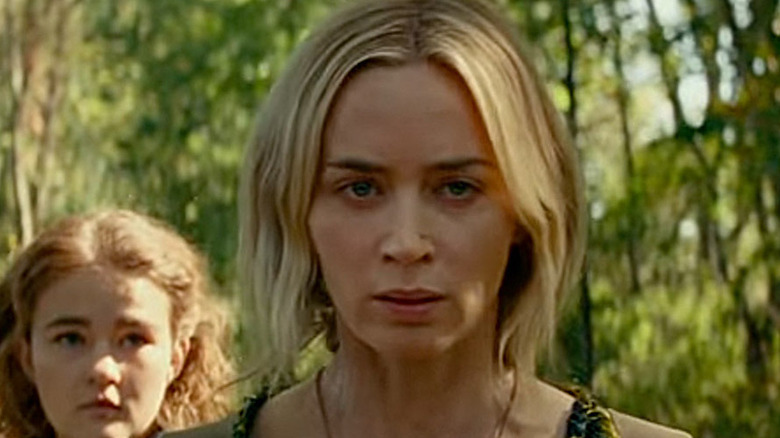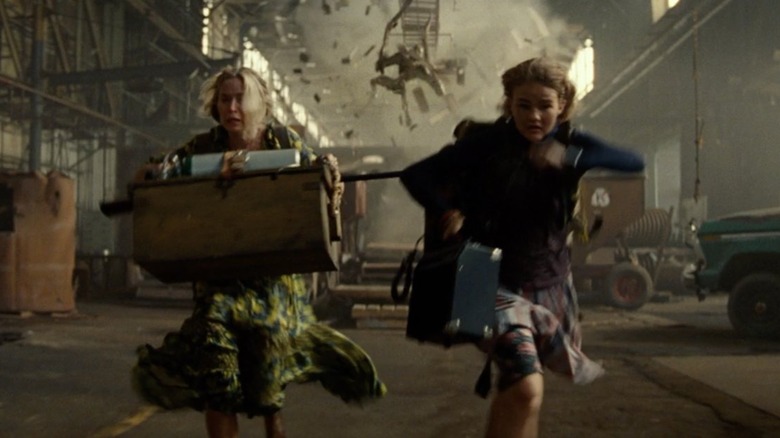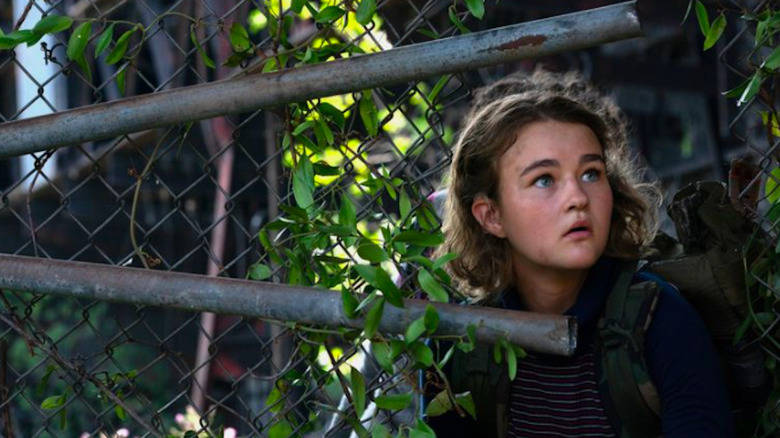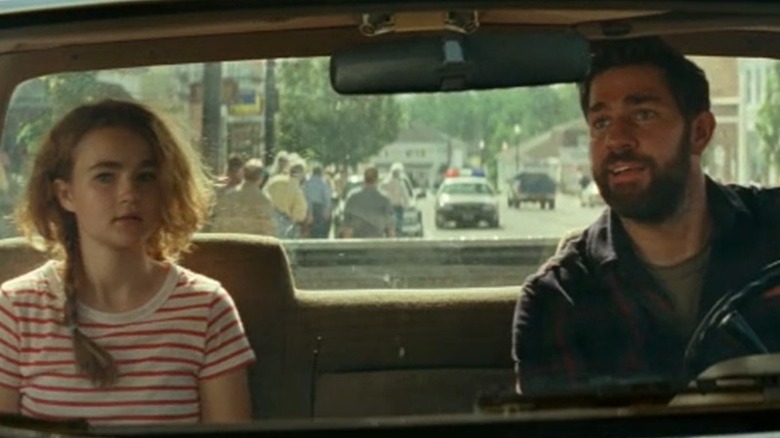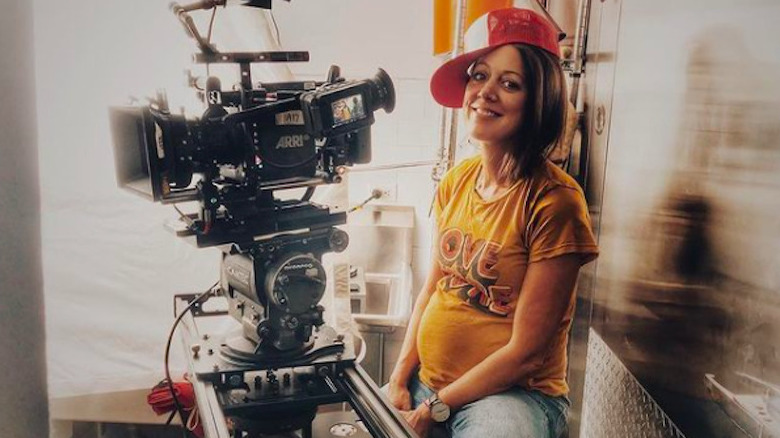Cinematographer Polly Morgan Shares What It Was Really Like Making A Quiet Place Part II - Exclusive Interview
A cinematographer's job is to make a movie look good and help visually convey its story through lighting, framing, camera angles, and many other duties. It's a task that often makes or breaks a film — and in the case of "A Quiet Place Part II," which is out now in theaters, the cinematography is part of what pushes the sequel to be as good, if not better than, the 2018 original. And for that, we have cinematographer Polly Morgan to thank.
Morgan got her start as a production assistant nearly 20 years ago, slowly moving up the Hollywood ladder doing camera work for films like "V for Vendetta" and the 2007 "Hairspray" remake and TV shows such as "American Horror Story." She then stepped into her current director of photography role for a couple of episodes of "Call the Midwife" and Marvel's short-lived "Legion" series.
While she wasn't involved in the original "A Quiet Place," whose director of photography was Charlotte Bruus Christensen, Morgan seamlessly stepped into the role for "Part II," which picks up where the original left off. The sequel once again follows the Abbott family as they quietly try to survive in a world where bloodthirsty monsters with an acute sense of hearing are ready to pounce at any second. While the first film focused on the deliberate silence they must endure at their family compound, the second film switches things up and offers more action as the Abbotts go on the move and look to thwart the grotesque beasts.
"Office" star John Krasinski returns as director of "A Quiet Place Part II" and resurrects his character, family patriarch Lee Abbott, in a revealing flashback sequence. The film also stars Krasinski's real-life wife Emily Blunt, Cillian Murphy, Millicent Simmonds, and Noah Jupe.
In an exclusive interview with Looper, Morgan opened up about what went into making "A Quiet Place Part II," how being a new mother influenced her work on the film, and the unfortunate accident that happened on set that changed how scenes were shot.
Polly Morgan thinks A Quiet Place Part II needs to be watched on the big screen
I got to see "A Quiet Place II" in the theater, which was exciting because it was the first time I've seen a movie on the big screen since the COVID-19 pandemic started a year and a half ago. I forgot how much I missed doing that. Why is seeing this film on the big screen so important?
Well, I think this film just has so many different emotional cues. It really kind of plays with the viewer, whether it's terrifying them or pulling at their heartstrings. At times even, I don't know, just sort of creating humor. I mean, I think that when you go to a movie like that with a group of people, the experience is elevated because when there's 100 other people sort of going on that ride with you, it's the gasps in the room, the jump scares, or when you're sort of holding on to the edge of your seat. You can't hear a sound, because no one's even eating their popcorn, because the movie is so much of a ride. It's just a good movie to sort of share with other people.
What drew you to this film? What about the first movie made you want to jump in on the second one?
I didn't actually watch the first movie until I'd had my first baby, who's now two and a half years old. I'm not the biggest fan of horror movies, to be honest, but when I watched this one, I was just so drawn in by the family drama of it all about these parents trying to protect their children. It could've been anything that was the source of the danger. To me, the heart of the film was a story about this family. I think being a new mother, it just really spoke to me in so many ways.
To be honest, I was kind of nervous about doing a sequel. I wasn't really sure it was something that I wanted to do, especially because the first film was so well received and such a big hit that it was kind of nerve-wracking. John's script was so beautifully written. It was very much written how he saw the film. As the cinematographer, the images just flew off the page, and it really just drew me in.
As a mother of a two-and-a-half-year-old myself, it was very harrowing watching any scene involving the newborn baby. And you mentioned you had just had your baby when you were working on this. How did that affect the way you approached the film?
I didn't really realize when I was working on the movie how much being a mother was impacting my decisions and also my experience, because I was breastfeeding the whole time, so my hormones were all over the place. It was a very emotional experience to sort of do very intimate scenes with the family. There's one scene in particular with Emily sort of being with the baby in the underground room with her other two children. Often, the scenes would sort of bring me to tears. I think it was just, again, this movie, like the first movie, is centered very much around the family and how their experience of what's happening in the world is impacting their life, and what they need to do to survive.
I was really on the edge of my seat during the scene when the son and the baby are in the furnace together...
Yeah, me too. But I'm making the movie, I'm not sort of immersed in the story. I'm actually there just helping it come to life. When the [actor] babies came to set, and when we were putting those babies in the box, I was just like, "Oh my God, the babies!" John, like me, he's quite an emotional person too. We would often look at each other, and we'd both be welling up. It was quite nice to sort of share that experience with him.
Millicent Simmonds was an 'absolute powerhouse' on the set of A Quiet Place Part II
Can you talk a little about the different techniques you used to shoot the three main stars of the film: John, Emily, and Cillian?
I mean, I didn't really necessarily use different techniques for each character. I think what was interesting about this film particularly is there's so much action to it in comparison to the first one, because the characters are always on the move, and quite often on the move in a very dynamic way. They're usually running for their lives, so it was really sort of the contrast of shooting those scenes that had very high energy, and then shooting the quieter scenes, and sort of returning back to a more grounded feel of drama, and of intimacy, and of real performance.
I really loved shooting the more action-heavy sequences, and was very challenged by them. I hadn't done a lot of that before, so it was definitely exciting to sort of figure out how to pull all that stuff off. For me, just returning to the quieter scenes with the performance, and just being very intimate with the actors, I think those are my favorite things to do. We chose to shoot it all in a very subjective way. We really wanted the viewers to share as much of the experience as the Abbotts did, and kind of draw them into their world. We shot the movie with anamorphic lenses, but we really sort of leaned into the wider lenses and were very close with the actors and very much in their space, just to try and experience the world with them.
Who was your favorite character to shoot and why?
Good question. God, it's a hard one. I mean, I think Emily is so captivating on the screen, and I have an affinity for her as a mother. But I think that Regan, who's played by Milli, she was an absolute powerhouse. Being a deaf actor is such an incredible feat. And as a young actor on top of that, and for her to give the performance that she gave, and even her character's journey of being the strong one and sort of going out on the road to try and save her family and the world, I felt that was so powerful. Really, her relationship with her father, and sort of the guilt that she felt about being responsible for his death, and carrying that with her, and sort of Cillian's character losing his wife, and then kind of coming together at the end was just really powerful.
Was it off-putting at all to be on set, how quiet and in slow-motion things can get?
I think that what is interesting working on movies is whatever type of film that you're working on kind of has a big impact on the mood or sort of the environment of the crew. Sometimes it would be very, very real at times, because of the horror aspect of it, or the really intense scenes. Everybody that's there would get quite quiet. Sort of the atmosphere of the words that were being spoken, or what part of the story we were telling sometimes. That quietness that we were sort of conveying on the screen just kind of found its way onto set, and that mood sort of spread around. I think it's a really interesting thing, about the energy of the scene and how it translates on the screen and to the people that are making the movie.
Polly Morgan dishes on working with John Krasinski, Emily Blunt, and Cillian Murphy
What was it like working with John Krasinski in a dual role, as an actor and a director? Is he the same guy no matter which hat he's wearing, or does his personality change depending on where his head is at?
Well, I think that John had a really strong creative vision for the film. He was really only involved [as an actor] in the first couple of weeks, because we shot the day one prologue at the top of the schedule. He was very trusting in us in that once he did a take, he would come back, and he would sort of say, "Did we get it?" If we said, "Oh, no. We didn't get it. You better go again," he didn't need to watch playback. He would just trust us, and then we would do it again. I think he handled it all really well. I mean, there was a lot of big stuff that was happening in that prologue sequence. It was this sort of dance of all the departments working together: the special effects, the stunts, visual effects, camera, all the extras, and all the [other] stuff that had to happen.
We spent a long time in prep kind of working out the sequence, and spent a lot of time trying to figure out how we were going to shoot it. I think it was a relief for him when he could kind of put his actor hat to bed and just focus on directing. I thought he did a great job. It really didn't change his way of working at all.
Why do you think it was important for him to appear in the sequel?
I'm not sure that I think that he necessarily thought it was important, but I think he wanted to contextualize and explain what happened on day one when the creatures arrived, because the first movie never really explained that. You're thrown into this current state of this family and the world that they're living in, but you never really go into too much depth of what happened, and who they were, and how they arrived. I think it was just important for him to tell that story, and make the rest of the world make sense.
Emily Blunt's character is very solemn and stoic for obvious reasons, but what is she like in real life?
She is such a joy to work with. She's one of those actors that isn't method at all. She's sort of laughing and chatting one moment, and then when the cameras are rolling she's really in it and just finds her space. John and her have two kids together, and they would often come to set. I think that sense of being a wife and a mother, and then also being an actor, that was all just part of it on a day to day basis ... I'm not quite sure how she was able to sort of switch off and just put herself in Evelyn's mindset so easily. She was a wonderful actor.
Any memorable moments with John, Emily, or Cillian — or anything that really stands out?
Well, the sequence where the characters are sort of running through the inside of the steel mill in that first altercation with the creature, and they have to jump into that giant vat. They slide into the underground room, and they're going to hide in the furnace ... The actors had slid down into the furnace, both Cillian and Milli, and they were running toward the furnace door to jump in. Cillian trod on Milli's toe and broke it. Poor Milli had to spend the rest of the shoot in a boot.
Not only did her character have to do a lot within the film, she had to do it with a broken toe. It wasn't funny at all, but it was just things happen often when you're shooting a movie. I mean, I'm on a movie right now, and one of the lead actors has sprained his ankle. It just makes things more complicated with the schedule, Milli having to rest and how to shoot around her boot. That was definitely one of the things that we had to deal with.
Polly Morgan has seen the industry diversify since the Me Too movement took off
In the history of the Academy Awards, only one woman has ever been nominated for Best Cinematography — Rachel Morrison in 2017 for "Mudbound." Is it challenging to be a woman in this particular field of the film industry?
I think that it used to be incredibly challenging. I think that when I first started out as a PA and a camera assistant, it was definitely a really rare thing to be a female DP, or even to be a female on set. I was very aware that when I left [the American Film Institute's AFI Conservatory as a student] it was going to be harder for me to get jobs than my male counterparts. That was something that was just a fact and that was just understood, but it didn't put me off. It actually made me more determined.
Then the Me Too movement happened, and Black Lives Matter happened. I think that people are now extremely conscious of diversity, and are aware of the positive impact that having a very diverse group of people on set can bring. I think that it's important for everybody of all different colors, and all different races, to be telling stories that can be watched and seen all around the world, because I think that films are sort of the most accessible art form of the century.
I'm so pleased that more and more women are becoming cinematographers. I see more and more women [in general] out on set, and I know there's a lot of organizations and collectives of female DPs. I constantly see in the media lots of younger women doing great, great work. I think it's really changing, and I think soon it won't even be a topic of discussion anymore.
I'm always conflicted about asking questions like that, but I feel like we still have to talk about it in order to move forward...
Yeah, I was sad that there were no females nominated this year [at the Academy Awards]. I think it is really hard to adjust the balance. But I think we're starting to do it. And I really hope that by the time my daughter is a teenager we will have done much better at hiring consciously.
On that note, I'll wrap things up. Thanks again for your time. I really enjoyed the film...
Well, that makes me so happy. I don't know why there's this thing that sometimes the hardest movies to shoot end up being the best ones. When you're in the trenches and you're like, "Oh my God. How are we going to do this? This is so hard." Then, at the end, all the sort of toil and heartache is worth it, because people want to watch the movie.
"A Quiet Place Part II" is now out in theaters.
